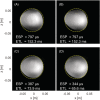A plug-and-play, lightweight, single-axis gradient insert design for increasing spatiotemporal resolution in echo planar imaging-based brain imaging
- PMID: 33619838
- PMCID: PMC8244051
- DOI: 10.1002/nbm.4499
A plug-and-play, lightweight, single-axis gradient insert design for increasing spatiotemporal resolution in echo planar imaging-based brain imaging
Abstract
The goal of this study was to introduce and evaluate the performance of a lightweight, high-performance, single-axis (z-axis) gradient insert design primarily intended for high-resolution functional magnetic resonance imaging, and aimed at providing both ease of use and a boost in spatiotemporal resolution. The optimal winding positions of the coil were obtained using a genetic algorithm with a cost function that balanced gradient performance (minimum 0.30 mT/m/A) and field linearity (≥16 cm linear region). These parameters were verified using field distribution measurements by B0 -mapping. The correction of geometrical distortions was performed using theoretical field distribution of the coil. Simulations and measurements were performed to investigate the echo planar imaging echo-spacing reduction due to the improved gradient performance. The resulting coil featured a 16-cm linear region, a weight of 45 kg, an installation time of 15 min, and a maximum gradient strength and slew rate of 200 mT/m and 1300 T/m/s, respectively, when paired with a commercially available gradient amplifier (940 V/630 A). The field distribution measurements matched the theoretically expected field. By utilizing the theoretical field distribution, geometrical distortions were corrected to within 6% of the whole-body gradient reference image in the target region. Compared with a whole-body gradient set, a maximum reduction in echo-spacing of a factor of 2.3 was found, translating to a 344 μs echo-spacing, for a field of view of 192 mm, a receiver bandwidth of 920 kHz and a gradient amplitude of 112 mT/m. We present a lightweight, single-axis gradient insert design that can provide high gradient performance and an increase in spatiotemporal resolution with correctable geometrical distortions while also offering a short installation time of less than 15 min and minimal system modifications.
Keywords: EPI, gradient coil, insert, magnetic resonance imaging, plug-and-play.
© 2021 The Authors. NMR in Biomedicine published by John Wiley & Sons Ltd.
Figures







References
-
- Mansfield P. Multi‐planar image formation using NMR spin echoes. J Phys C Solid State Phys. 1977;10(3):L55‐L58.
-
- Turner R, Jezzard P, Wen H, et al. Functional mapping of the human visual cortex at 4 and 1.5 tesla using deoxygenation contrast EPI. Magn Reson Med. 1993;29(2):277‐279. - PubMed
-
- Wong EC. Local head gradient coils: Window(s) of opportunity. Neuroimage. 2012;62(2):660‐664. - PubMed
Publication types
MeSH terms
LinkOut - more resources
Full Text Sources
Other Literature Sources

